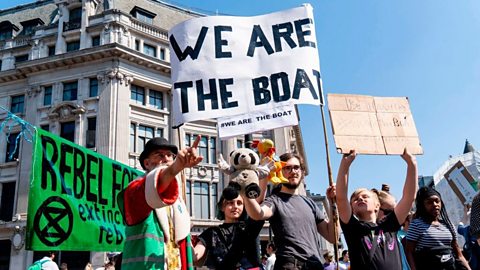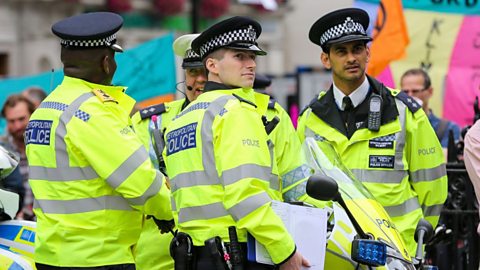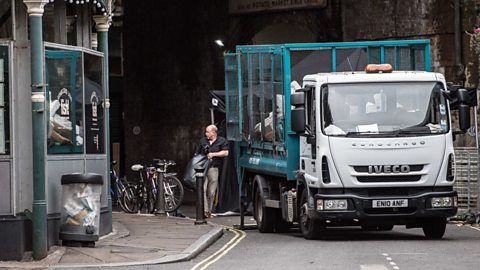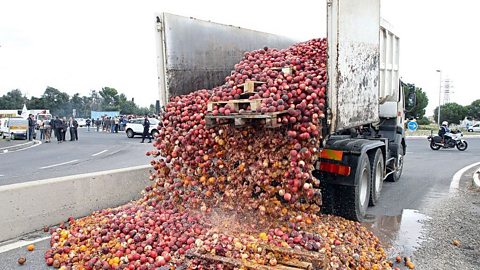This article was last updated in October 2019
When you see a strike on TV, do you get the impression people just turn up, wave a placard and head home?
Thatās not quite how it works ā lots of hard work goes on to make sure lawful demos are safe and run smoothly. “óĻó“«Ć½ Bitesize spoke to some key players about what happens behind the scenes.
The protest organisers ā āWe put a lot of trust in each other to organiseā
Robin Boardman, an organiser for environmental campaign group Extinction Rebellion (XR), explained for them it all starts with local meetings, usually on university campuses or in town community centres. Once an action is planned, people will split into working groups focusing on specific areas, such as media relations and art.

He explained that there isnāt really anyone micromanaging the operation: āWe put a lot of trust in each other to organise.ā
Groups are coordinated via social media and messaging apps on smart phones, although previously popular methods are being abandoned by the younger generations:
āWeāve kind of moved past the days of trying to be able to tell how many people will come along to a protest via a Facebook event because young people donāt use Facebook. Theyāll just share it around in an Instagram chat, so itās actually got harder to know how many people will turn up because itās so decentralised.ā
On the day, itās important that the people taking part are kept safe. To do this, Robin said that they put call outs for stewards, who tend to be the parents of the younger demonstrators. Some XR groups hold training sessions too.
Lastly, he says a key part of keeping the participants safe is by communicating with the police. While Robin says they donāt ask for permission to protest, they do (and have to by law) tell the local police in advance where it will be taking place, so they know where to be in order to keep the peace.

The police ā āWe always try and have a positive relationship with the protestersā
As alluded to by Robin, police involvement in protests is crucial. When a force is contacted by a protest organisation, their Public Order Command Team will plan what proportionate policing plan should be put in place.
Superintendent Waheed Khan of the Metropolitan Police told “óĻó“«Ć½ Bitesize they will look at a variety of aspects, including whether they need to speak to other partners, for example those who look after travel and the Local Authority in the area.
Communication is also key with the protest organisers themselves. Supt. Khan explained: āWe always try and have a positive relationship with [the protesters].
āItās in our mutual interest if we can facilitate lawful protest as best as we can.
āBut also, for us itās important to make sure weāre safeguarding them, that weāre providing a safe environment and weāre keeping London moving.ā

Supt. Khan said theyāll often have an engagement team made up of liaison officers who are out on the ground, talking to protesters, organisers and the public.
Every so often, though, protests can get out of hand. When this happens, the police have a number of options at their disposal in order to keep the peace ā but first and foremost, they will talk to the protesters. After that, thereās a process which, as Supt. Khan explains, is led by a gold commander and a field commander set up:
āItās for them as the leadership to set the direction and the toneā¦ and then that message is relayed to all the officers on the ground and then theyāll act accordingly and proportionately.ā
Above all else, Supt. Khan says that the policeās role is to āfacilitate and enable a lawful protest to take place.ā

The local council ā āA protest can create one full refuse truckā
Thereās also one operation that need to happen when the placards have all been put away: the clean-up, which is looked after by local authorities.
Westminster is a place that sees protests on almost a daily basis. Tim Mitchell, Westminster City Councilās Deputy Leader, is specifically responsible for waste management in the area. He told “óĻó“«Ć½ Bitesize that āa protest of between 7000 and 12000 people will create between 5 and 10 metric tons of waste, which is equal to one full refuse truck.ā

After an āaverageā protest, Tim said the council works on the basis that the clean-up will take around two hours, about 20 staff will work on it and theyāll have about four or five different vehicles on the job too. Sometimes, that can involve picking up unusual items such as sailing boats, wooden forts and and, in one case, two tonnes of coal.
Usually the waste is recycled, but where thatās not possible, Westminster City Councilās waste āgoes to a large waste to energy plant down in South-East London which provides heat for a local housing estate and provides electricity for the National Grid.ā
Tim also said that itās important for protesters to think about the waste they leave behind.

Local businesses ā āGet all the information you canā
When large group of protesters gather in a town square, or march down a high street, the businesses in these areas are also affected.
Nathan Chew, the General Manager of Chamber Space at Manchesterās Chamber of Commerce, said that they rely on communication with Manchester City Council and the police in order to inform their member businesses about upcoming protests. He also said they have a whole team dedicated to monitoring whatās happening in the city, so they can alert businesses as soon as possible.
āThe first thing weāll do is look at how it affects our clients and put out a communications programme to make sure that everyone whoās coming into the city or coming into our venue that day is aware of how theyāll be affected in terms of transport and in terms of safety.ā
When it comes to safety, Nathan said that protests can vary in their level of risk. With spontaneous protests that might get violent, he said the Chamber of Commerce might suggest steering clear of the area, but ultimately it was down to the individual business.
He said the most important thing was to act like a scout and be prepared: āGet all the information you can so you can be best prepared so your staff arenāt affected, your productivity isnāt affected. If people need to be working from home you can make those arrangements and be wary with clients to prevent lost revenue and business in the future.ā
Five unusual protests in history
For years people have found interesting and creative ways of getting their voices heard.

An odour can be one of the the finest mood boosters around

Five flowers that made history
Flowers are used to mark life milestones, but their importance sometimes goes beyond personal stories.
